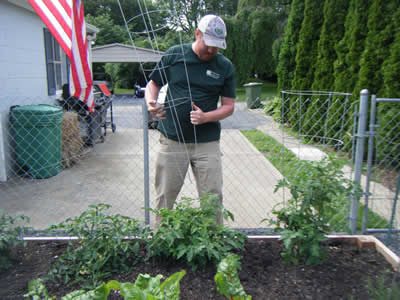So it’s nearly the end of May, and the garden veggies you planted in March, April and just last week are beginning to yield some great results. Now that things are growing and blooming, what should you be tending to, picking or otherwise doing with your raised bed garden? A few suggestions from GardenBedsNJ:
Harvesting lettuce. Nothing like a crisp, fresh salad straight from the back yard. At about this time, our garden has lovely lettuces to show for itself. Skip the grocery store trip in favor of stepping through the gate and gently tearing off some leaves of red romaine, butter lettuce, and mesclun greens for a spicy and healthy salad with your dinner.
Relocating and replacing. Maybe your kale took off and is now shading out a wayward onion. Perhaps the new tomato plants you bought won’t fit anywhere but in front of a row of climbing pea vines.
Consider the timing of the cool-weather loving crops versus the new, summer season veggies. The peas plants will be spent probably before July, so it’s okay to place a young tomato near them. By the time the tomato grows, the peas will be done and gone. If you don’t have replacements for your early spring crops, start strategizing your plan for where to put hot-weather loving plants.
Thinning things. That patch of carrot seeds that you sprinkled carelessly. The row of onions. The Burpee lettuce seed tape. A spill of broccoli seeds that you don’t remember dropping. To thin plants, use garden shears or little scissors to gently snip off the stem of the unwanted ‘tweeners. Or, try using a small shovel to gently dig up the roots, loosen the soil around them, and carefully pull the overcrowded young plants which can then be replanted in another location.
Caging tomatoes and peppers. If you’re gardening by the book and expect to eat tomatoes and peppers later this summer, then you should have planted them by May 15. Now is a good time to gently place cages around the small plants so that they’ll have something to cling to so the vines won’t drag on the ground and take the fruits with them. If you haven’t planted tomatoes or peppers, you can still get some. Just be sure to choose the largest plants you can find, to ensure that fruiting will occur well before the first frost of autumn.
Pulling weeds. As I mentioned on Facebook, we’re waiting to share photos of our garden until the wayward clover and other pesky weeds have been pulled! The best reason to remove weeds: garden pests love to make their home in weeds, and then come out to feast on your vulnerable young plants. Additionally, weeds leach nutrients from the soil that are better used by your veggies and herbs.
Composting. Organic compost is the secret to lush, green, vitamin and mineral-rich vegetables and herbs that stand up to pests and disease. We keep two compost tumblers right by the garden gate – one for making new compost, and the other containing seasoned compost that’s ready to use as fertilizer. Just grab some in a little pot, and sprinkle all around your growing garden plants. Water well, and you’re done. You won’t believe how quickly your garden will perk up from the simple addition of compost.
Are you a garden blogger? We’re interested in sharing your ideas. Email a pre-written article to info@gardenbedsnj.com. If it works with our current content, we’ll publish it on our site with your 2- or 3-line bio and a link back to your site. Thanks, and happy gardening, Zone 6!
